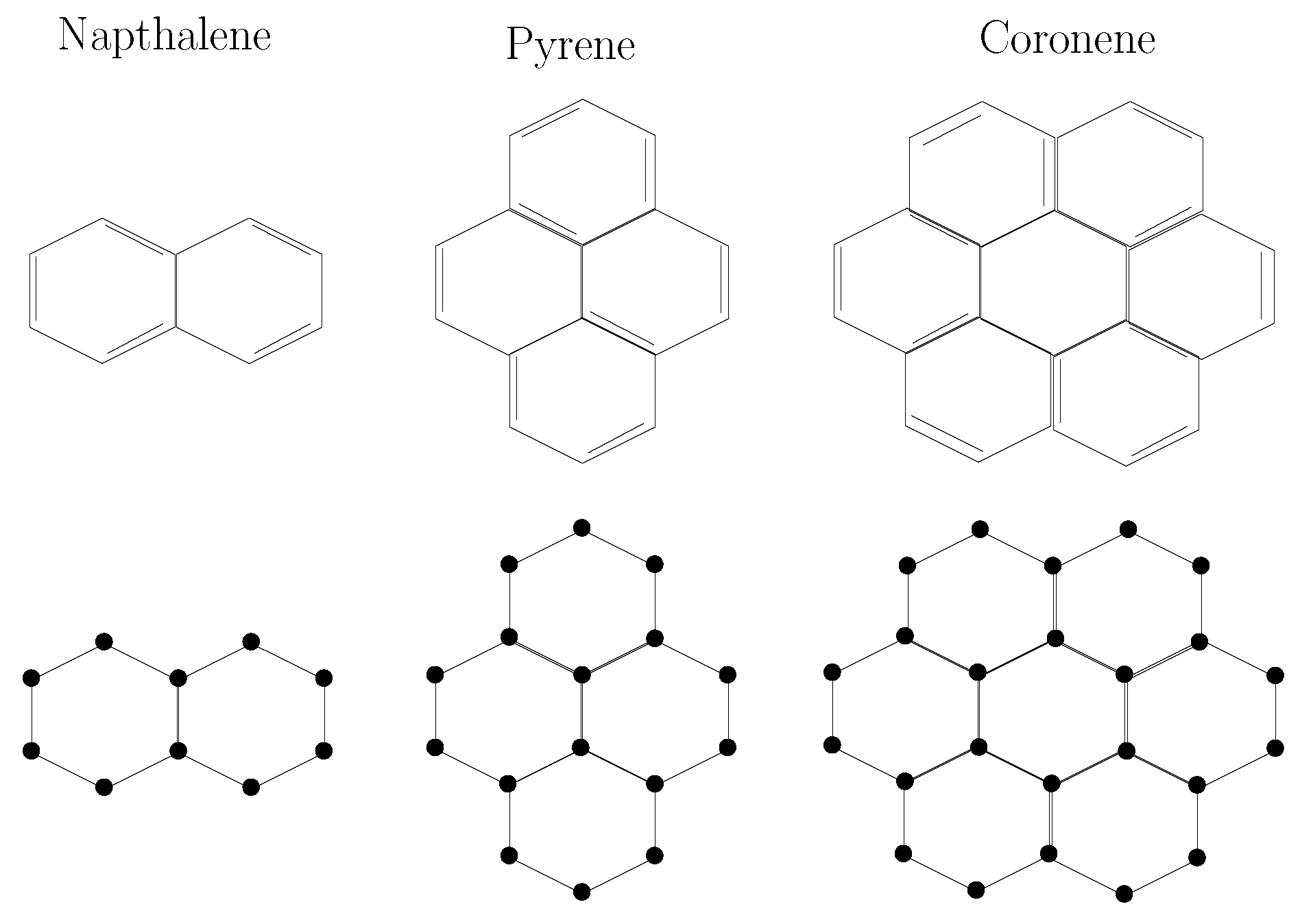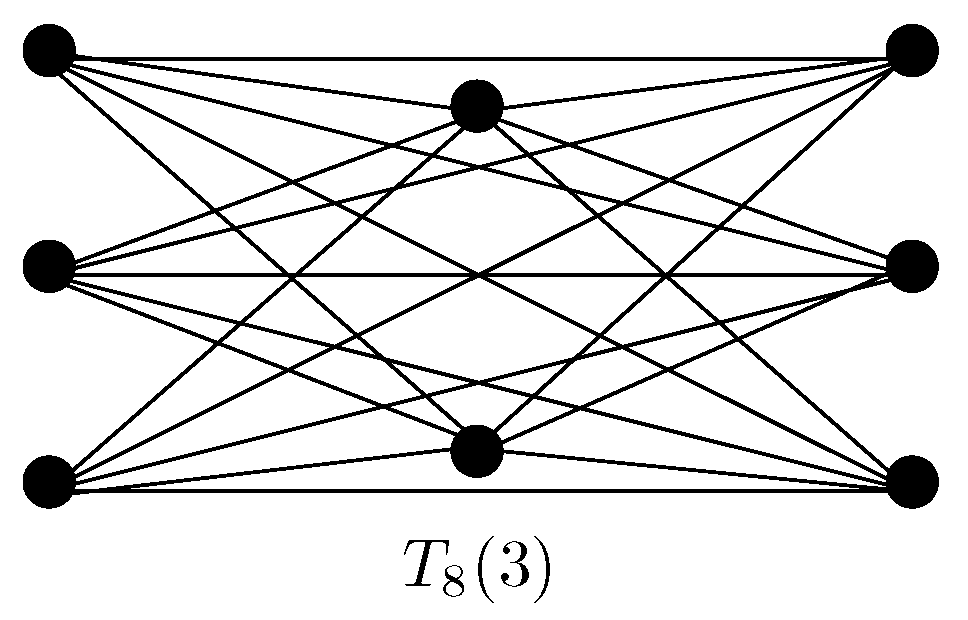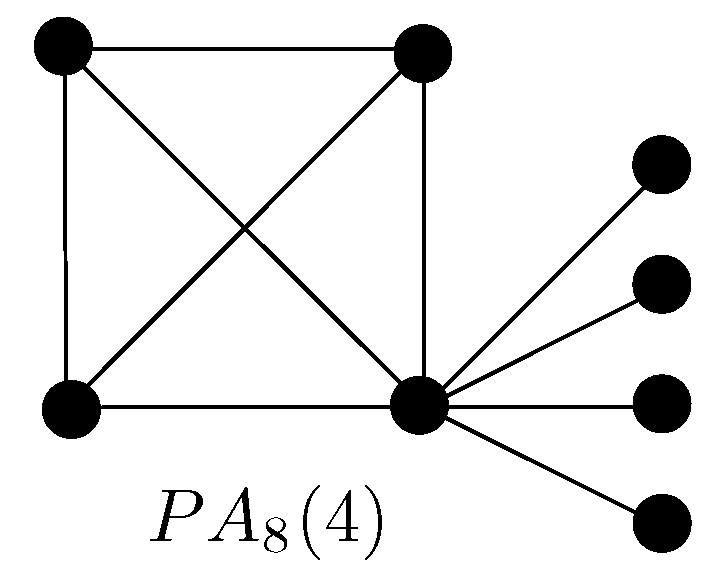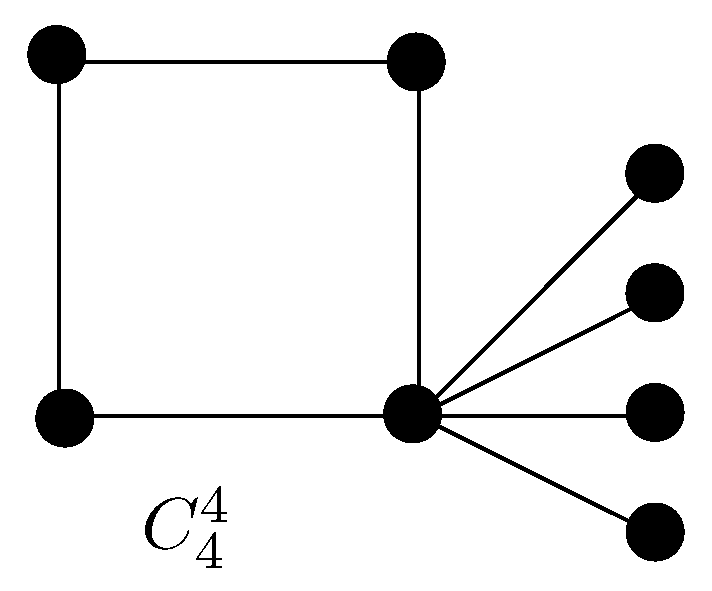Some Bounds on Zeroth-Order General Randić Index
Abstract
1. Chemical Graph Theory
2. Introduction
3. Preliminary Results
- 1.
- if ;
- 2.
- where x and y are non-isolated vertices in G.
4. Main Results and Discussion
4.1. Extremal Graphs w.r.t. Zeroth-Order General Randić Index in Terms of Chromatic Number and Clique Number
4.2. Extremal Graphs w.r.t. Zeroth-Order General Randić Index in Terms of Number of Cut Edges
4.3. Extremal Graphs w.r.t. in Terms of Vertex (Edge) Connectivity
5. Conclusions
Author Contributions
Funding
Conflicts of Interest
References
- Wiener, H. Structural determination of paraffin boiling point. J. Am. Chem. Soc. 1947, 69, 17–20. [Google Scholar] [CrossRef] [PubMed]
- Wiener, H. Vapor pressure-temperature relationships among the branched paraffin hydroarbons. J. Phys. Chem. 1948, 52, 425–430. [Google Scholar] [CrossRef] [PubMed]
- Wiener, H. Correlation of heats of isomerization, and differences in heats of vaporization of isomers, among the paraffin hydrocarbons. J. Am. Chem. Soc. 1944, 69, 2636–2638. [Google Scholar] [CrossRef]
- Amić, D.; Bešlo, D. The vertex-connectivity index revisited. J. Chem. Inf. Comput. Sci. 1998, 38, 819–822. [Google Scholar] [CrossRef]
- Andersen, J.L.; Fagerberg, R.; Flamm, C.; Kianian, R.; Merkle, D.; Stadler, P.F. Towards Mechanistic Prediction of Mass Spectra Using Graph Transformation. MATCH Commun. Math. Comput. Chem. 2018, 80, 705–731. [Google Scholar]
- Andersen, J.L.; Flamm, C.; Merkle, D.; Stadler, P.F. Rule Composition in Graph Transformation Models of Chemical Reactions. MATCH Commun. Math. Comput. Chem. 2018, 80, 661–704. [Google Scholar]
- Dobrowolski, J.C. The Structural Formula Version of Graph Theory. MATCH Commun. Math. Comput. Chem. 2019, 81, 527–555. [Google Scholar]
- Elphick, C.; Wocjan, P. Bounds and power means for the general Randic index. arXiv 2015, arXiv:1508.07950. [Google Scholar]
- Gupta, S.; Singh, M. Application of graph theory: Relationship of eccentric connectivity index and Wiener’s index with anti-inflammatory activity. J. Math. Anal. Appl. 2002, 266, 259–268. [Google Scholar] [CrossRef]
- Gupta, S.; Singh, M.; Madan, A.K. Eccentric distance sum: A novel graph invariant for predicting biological and physical properties. J. Math. Anal. Appl. 2002, 275, 386–401. [Google Scholar] [CrossRef]
- Nikolić, S.; Trinajstić, N. Comparison between the vertex and edge connectivity indices for benzenoid hydrocarbons. J. Chem. Inf. Comput. Sci. 1998, 38, 42–46. [Google Scholar] [CrossRef]
- Randić, M.; Zupan, J. On interpretation of well-known topological indices. J. Chem. Inf. Comput. Sci. 2001, 41, 550–560. [Google Scholar] [CrossRef] [PubMed]
- Stadler, B.M.R.; Stadler, P.F. Reachability, Connectivity, and Proximity in Chemical Spaces. MATCH Commun. Math. Comput. Chem. 2018, 80, 639–659. [Google Scholar]
- Todeschini, R.; Cazar, R.; Collina, E. The chemical meaning of topological indices. Chemom. Intell. Lab. Syst. 1992, 15, 51–59. [Google Scholar] [CrossRef]
- Bondy, J.A.; Murty, U.S.R. Graph Theory with Applications; Macmillan Press: New York, NY, USA, 1976. [Google Scholar]
- Kier, L.B.; Hall, L.H. The meaning of molecular connectivity: A bimolecular accessibility model. Croat. Chem. Acta 2002, 75, 371–382. [Google Scholar]
- Li, X.; Zheng, J. A unified approach to the extremal trees for different indices. MATCH Commun. Math. Comput. Chem. 2005, 54, 195–208. [Google Scholar]
- Pan, X.F.; Liu, H.L.M. Sharp bounds on the zeroth-order general Randić index of unicyclic graphs with given diameter. Appl. Math. Lett. 2011, 24, 687–691. [Google Scholar] [CrossRef][Green Version]
- Volkmann, L. Sufficient conditions on the zeroth-order general Randić index for maximally edge-connected digraphs. Commun. Comb. Opt. 2016, 1, 1–13. [Google Scholar]
- Yamaguchi, S. Zeroth-order general Randić index of trees with given order and distance conditions. MATCH Commun. Math. Comput. Chem. 2009, 62, 171–175. [Google Scholar]
- Jamil, M.K.; Tomescu, I. Zeroth-order general Randić index of k-generalized quasi trees. arXiv 2018, arXiv:1801.03885v1. [Google Scholar]
- Balasubramanian, K.; Ghadimi, S. Zeroth-order (non)-convex stochastic optimization via conditional gradient and gradient updates. In Proceedings of the 32nd International Conference on Neural Information Processing Systems (NIPS 2018), Montréal, QC, Canada, 3–8 December 2018; pp. 3455–3464. [Google Scholar]
- Chen, Z.; Su, G.; Volkmann, L. Sufficient conditions on the zeroth order general Randić index for maximally edge-connected graphs. Discret. Appl. Math. 2017, 218, 64–70. [Google Scholar] [CrossRef]
- Hu, Y.; Li, X.; Shi, Y.; Xu, T. On molecular graphs with smallest and greatest zeroth-order general Randić index. MATCH Commun. Math. Comput. Chem. 2005, 54, 425–434. [Google Scholar]
- Imani, M.; Dougherty, E.R.; Neto, U.B. Boolean Kalman filter and smoother under model uncertainty. Automatica 2020, 111, 108609. [Google Scholar] [CrossRef]
- Li, X.; Shi, Y. (n,m)-Graphs with maximum Zeroth-order general Randić index for α ∈ (−1, 0). MATCH Commun. Math. Comput. Chem. 2009, 62, 163–170. [Google Scholar]
- Su, G.; Meng, M.; Cui, L.; Chen, Z.; Xu, L. The general zeroth-order Randić index of maximal outerplanar graphs and trees with k-maximum degree vertices. Sci. Asia 2017, 43, 387–393. [Google Scholar] [CrossRef]
- Su, G.; Tu, J.; Das, K.C. Graphs with fixed number of pendent vertices and minimal zeroth-order general Randić index. Appl. Math. Comput. 2016, 270, 705–710. [Google Scholar] [CrossRef]
- Su, G.; Xiong, L.; Su, X. Maximally edge-connected graphs and general Zeroth-order Randić index for 0 < α < 1. Discret. Appl. Math. 2014, 167, 261–268. [Google Scholar]
- Su, G.; Xiong, L.; Su, X.; Li, G. Maximally edge-connected graphs and general zeroth-order Randić index α < −1. J. Comb. Optim. 2016, 31, 182–195. [Google Scholar]
- Ye, J.; Yao, Y. A note on the zeroth-order general Randić index of polygonal cacti. Open J. Dis. Appl. Math. 2018, 1, 01–07. [Google Scholar] [CrossRef]
- Zhang, S.; Wang, W.; Cheng, T.C.E. Bicyclic graphs with the first three smallest and largest values of the first general Zagreb index. MATCH Commun. Math. Comput. Chem. 2006, 56, 579–592. [Google Scholar]
- Zhang, H.; Zhang, S. Unicyclic graphs with the first three smallest and largest first general Zagreb index. MATCH Commun. Math. Comput. Chem. 2006, 55, 427–438. [Google Scholar]
- Lin, A.; Luo, R.; Zha, X. On sharp bounds of the zero-order Randić index of certain unicyclic graphs. Appl. Math. Lett. 2009. [Google Scholar] [CrossRef]
- Pavlović, L. Maximal value of the zeroth-order Randić index. Discret. Appl. Math. 2003, 127, 615–626. [Google Scholar] [CrossRef]
- Fajtlowicz, S. On conjectures of graffiti II. Congr. Numer. 1987, 60, 189–197. [Google Scholar]
- Hu, Y.; Li, X.; Shi, Y.; Xu, T. Connected (n,m)-graphs with minimum and maximum zeroth-order general Randić index. Discret. Appl. Math. 2007, 155, 1044–1054. [Google Scholar] [CrossRef]
- Li, X.; Shi, Y. On the diameter and inverse degree. Ars Comb. 2011, 101, 481–487. [Google Scholar]
- Mukwembi, S. On diameter and inverse degree of a graph. Discret. Math. 2010, 310, 940–946. [Google Scholar] [CrossRef][Green Version]
- Zhang, Z.; Zhang, J.; Lu, X. The relation of matching with inverse degree of a graph. Discret. Math. 2005, 301, 243–246. [Google Scholar] [CrossRef]
- Xu, K.; Das, K.C. Some extremal graphs with respect to inverse degree. Discret. Appl. Math. 2016, 203, 171–183. [Google Scholar] [CrossRef]
- Li, X.; Zhao, H. Trees with the first three smallest and largest generalized topological indices. MATCH Commun. Math. Comput. Chem. 2004, 50, 57–62. [Google Scholar]




© 2020 by the authors. Licensee MDPI, Basel, Switzerland. This article is an open access article distributed under the terms and conditions of the Creative Commons Attribution (CC BY) license (http://creativecommons.org/licenses/by/4.0/).
Share and Cite
Jamil, M.K.; Tomescu, I.; Imran, M.; Javed, A. Some Bounds on Zeroth-Order General Randić Index. Mathematics 2020, 8, 98. https://doi.org/10.3390/math8010098
Jamil MK, Tomescu I, Imran M, Javed A. Some Bounds on Zeroth-Order General Randić Index. Mathematics. 2020; 8(1):98. https://doi.org/10.3390/math8010098
Chicago/Turabian StyleJamil, Muhammad Kamran, Ioan Tomescu, Muhammad Imran, and Aisha Javed. 2020. "Some Bounds on Zeroth-Order General Randić Index" Mathematics 8, no. 1: 98. https://doi.org/10.3390/math8010098
APA StyleJamil, M. K., Tomescu, I., Imran, M., & Javed, A. (2020). Some Bounds on Zeroth-Order General Randić Index. Mathematics, 8(1), 98. https://doi.org/10.3390/math8010098






